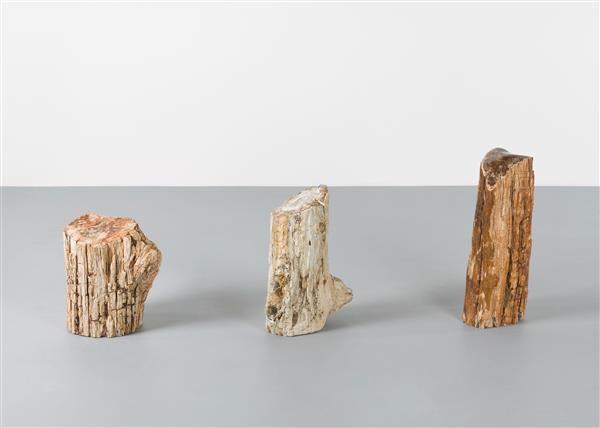Allochthone #4, #6, #7
Christian Kosmas Mayer
petrified tree trunks from Madagascar, ca. 200 million years old
variable, each max. 50 × 28 ×19 cm
2012
Acquisition 2013
Inv. No. 0247abc
What unites the archaeologists of the existential in the city ruins of Pompeii with the more period history of Voyager’s golden record, or the disposable articles in Andy Warhol’s cardboard boxes, is the fact that they all belong to one category: that of the time-capsule.
In mid-20th century America, the interrelation of place and time was as popular as the new, up-and-coming television. No cornerstone was laid, no spaceship sent, no world-exhibition opened, without depositing a container with civilizing messages for the future.
For the series Putting in time, artist Christian Mayer analyzes the time-capsule phenomenon: type, place, depositing and opening ceremonies, content. For the project, he scoured flea-markets and the Internet, searching for press-photos in current and historical newspaper archives that showed images of the subject. The artist copied and enlarged the handwritten notes, agency stamps as well as the pasted copies of the published articles on the backside of the press-photos themselves to use as mats for the photos. Most document events of local interest, such as the inhabitants of Aurora, IL, who dressed in timely costumes for the celebrated opening of an 1877 capsule made by veterans of the American Civil War (1861-5). On the occasion of the 150th anniversary of the city in 1987, the time capsule, which had been planted in the cornerstone of the meeting house and museum, was opened. Inside they found a bible, coins, newspapers from July 3rd, 1877 and a bound copy of local happenings from the time of the Civil War.
Fallen out of time, the document of happenings – in itself a kind of time-capsule – developed new energy in Mayerʼs new context.
The wall-pieces are assigned Allochthone, petrified tree trunks from Madagascar. The trees have survived 200 million years underwater without oxygen in an alluvial plain, buried in volcanic ash. Sediment slowly penetrated the trunks – wood became stone. The transformed material retained form and appearance; only where it has been sanded and polished do the points of fracture glimmer like gemstones. Beyond the purely biological sense of “morphing”, the artist reveals a multifaceted new chapter about copy and counterfeit. The reception of art is formatted through interpretations, explanations and commentaries. Seeing without presuppositions, so the message, is not possible.
Brigitte Huck, 2015 (translation: Virginia Dellenbaugh)
Continue readingExhibitions
Days of Future Just Past. Curated by Brigitte Huck & Martin Guttmann, Galerie Charim, Vienna, 2015
The World Without Us, LENTOS Kunstmuseum Linz, Linz
Publications
evn collection. 95–2015 Jubilee, Vienna 2015, p. 266–269


